Dice Throne Season 2: Gunslinger Vs Samurai — Rolling brawl
If you like a light, airy board game that doesn’t take itself too seriously, then among the many options available to you is the noble dice chucker. Since the origins of gaming, human beings have revelled in the fun of throwing roughly even-sided objects onto tables and then shouting and jeering about the results. Aside from the quality of what is being thrown, not much has changed this genre in hundreds of years, but now, there’s Dice Throne: Season Two: Battle 1: Gunslinger vs Samurai and everything has changed.
Well, actually, some things have changed. For starters, you won’t find a more gloriously presented dice rolling game than Dice Throne: Season Two. From the small, tightly packed boxes that each pair of combatants nestles in, to the individual game trays that hold the components for each fighter, Dice Throne: Season Two is out to impress. The fold out boards that explain each fighter? Magnificent. The dice, cards and tokens? Absolutely top draw.
Dice Throne: Season Two is Roxley Game laboratories at its very best (except of course when they are really at their very best) and it shows in the thickness of the pieces, the colours of the custom dice, just the sheer class of the whole thing. I wouldn’t normally go on about components to this extent, but when it comes to dice rolling games, the gameplay is often so wafer thin that the eye candy becomes twice as important as it might normally be.
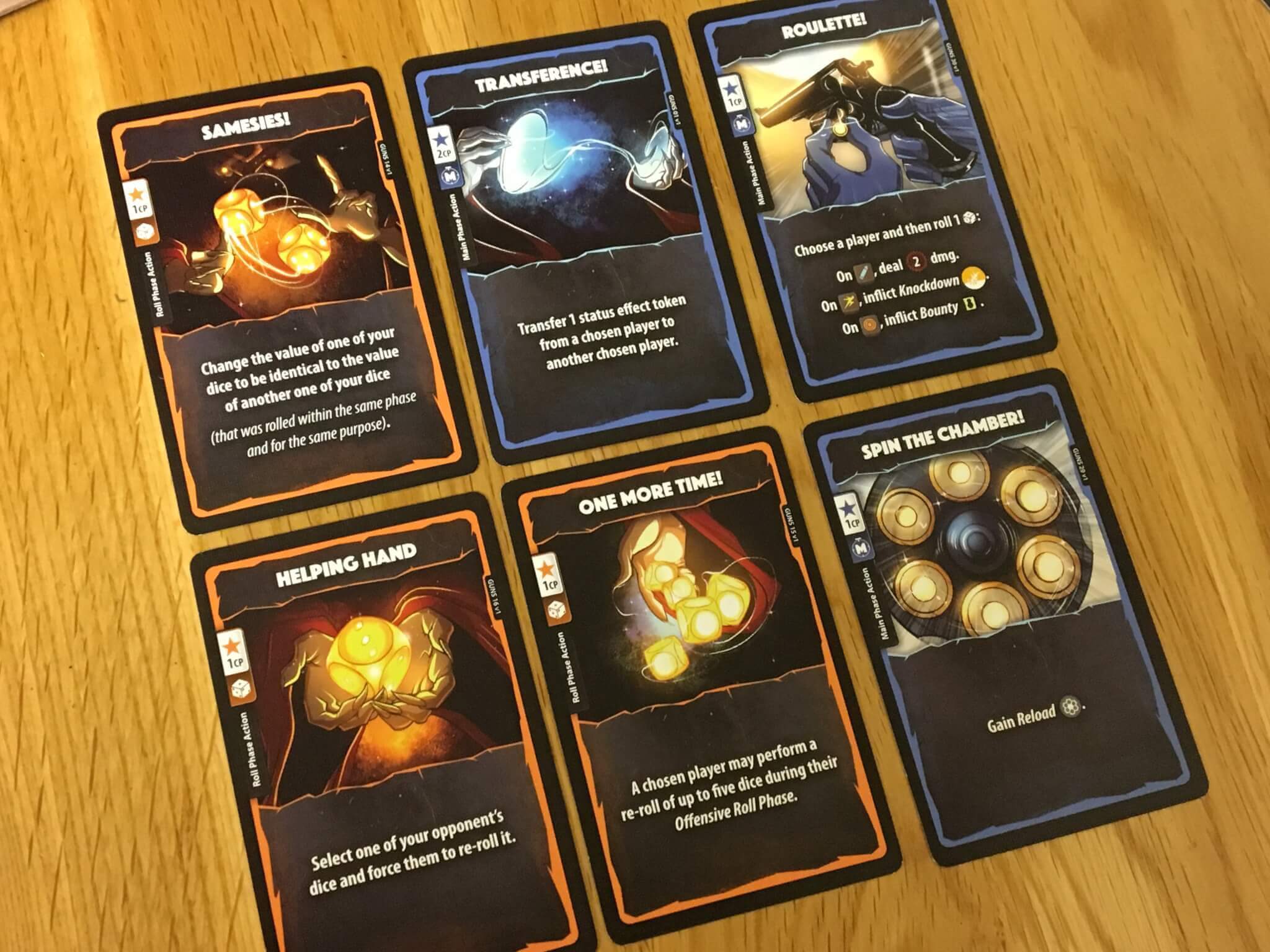
Where Dice Throne: Season Two is concerned, that’s kind of true, but not to the same extent as it often is. You see, whilst this review specifically deals with the two titular characters in the single battle box known as Dice Throne: Season Two: Battle 1: Gunslinger vs Samurai, there are actually several boxes to choose from, each with their own combination of interesting and varied fighters.
Both the gunslinger and the samurai from my battle box are interesting in their own right, but they are fairly simple to use and quite run of the mill in terms of their overall set of skills and associated rules. Other characters come with much more interesting and varied features, including companions, additional decks of cards and other unique ways to modify their dice rolls or otherwise affect the battle.
With this in mind, you may be able to start to picture what Dice Throne: Season Two is all about, it’s really a modular system that allows players to experience the basics of the game before then expanding their collection of fighters to allow different combinations — including the potential for multiplayer battles. Spoiler alert, there’s also an upcoming expandalone adventure game called Dice Throne Adventures which we’ll be reviewing shortly.
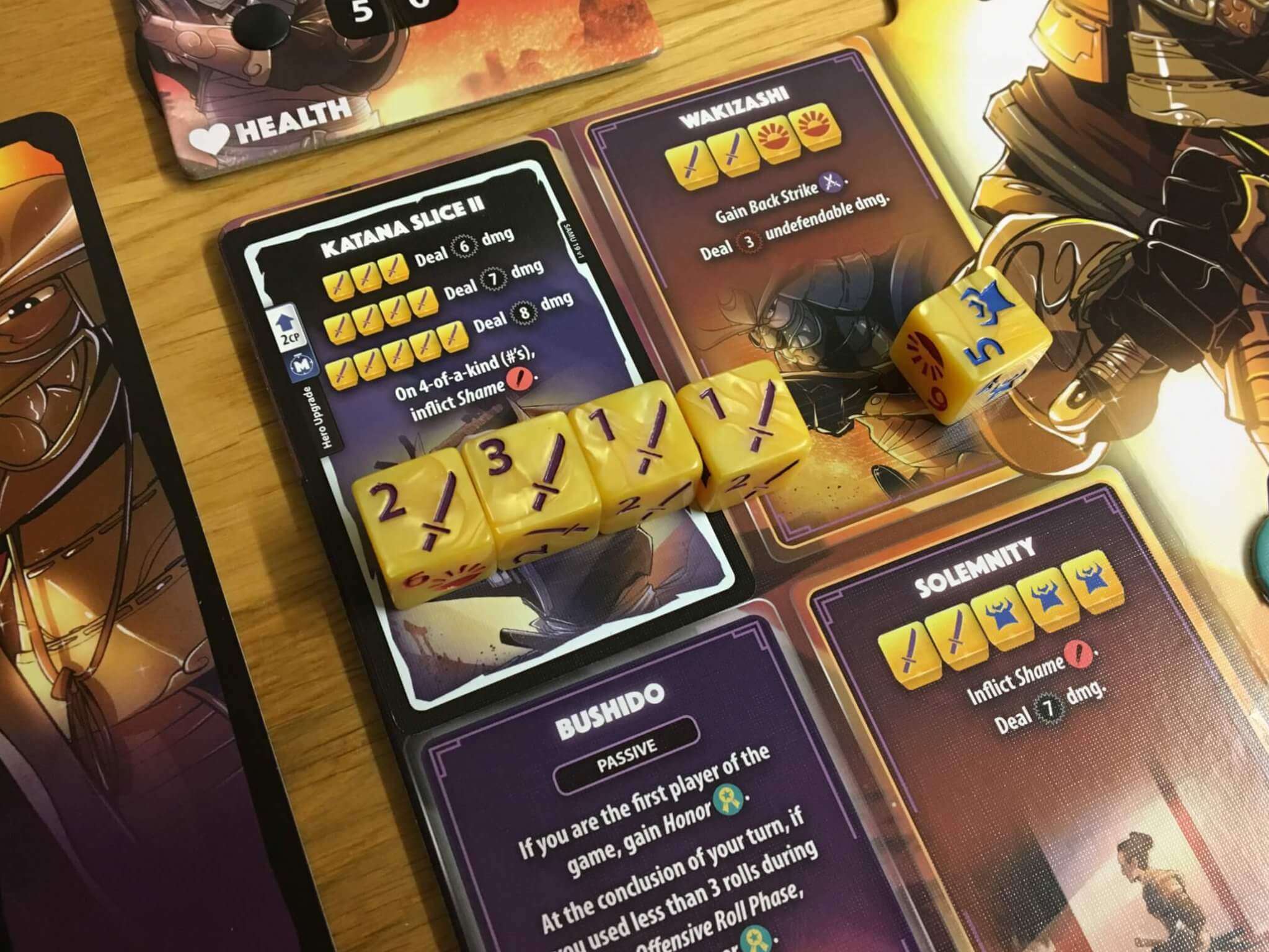
As for what you actually do in Dice Throne: Season Two, well I’ve already mentioned that it’s not quite as simple as a standard dice chucker, but it does keep things nicely straightforward. Typically played as a one versus one game, each player is assigned their health total (usually fifty points) a set of dice and a deck of cards. From this deck, they’ll deal themselves a starting hand and a number of combat points.
From this point on, the players will take turns to play through several phases including income (draw a card and add a combat point to their dial), a main phase, attack rolls, defence roll, another main phase and another income. The income phases are used to ensure that the players continue to have a range of options, whilst the dice rolls represent the real meat of the action.
By using combat points, players will use cards from their hand to either upgrade their skillset, enhance their own attack or disrupt their opponent (often on their turn) in some way. These cards are almost always linked thematically to the kind of character using them — the samurai can inflict honour on himself for a bonus, or shame his opponent to debuff them, whilst the gunslinger can use the cards to “reload” effectively allowing her additional rerolls and similar.
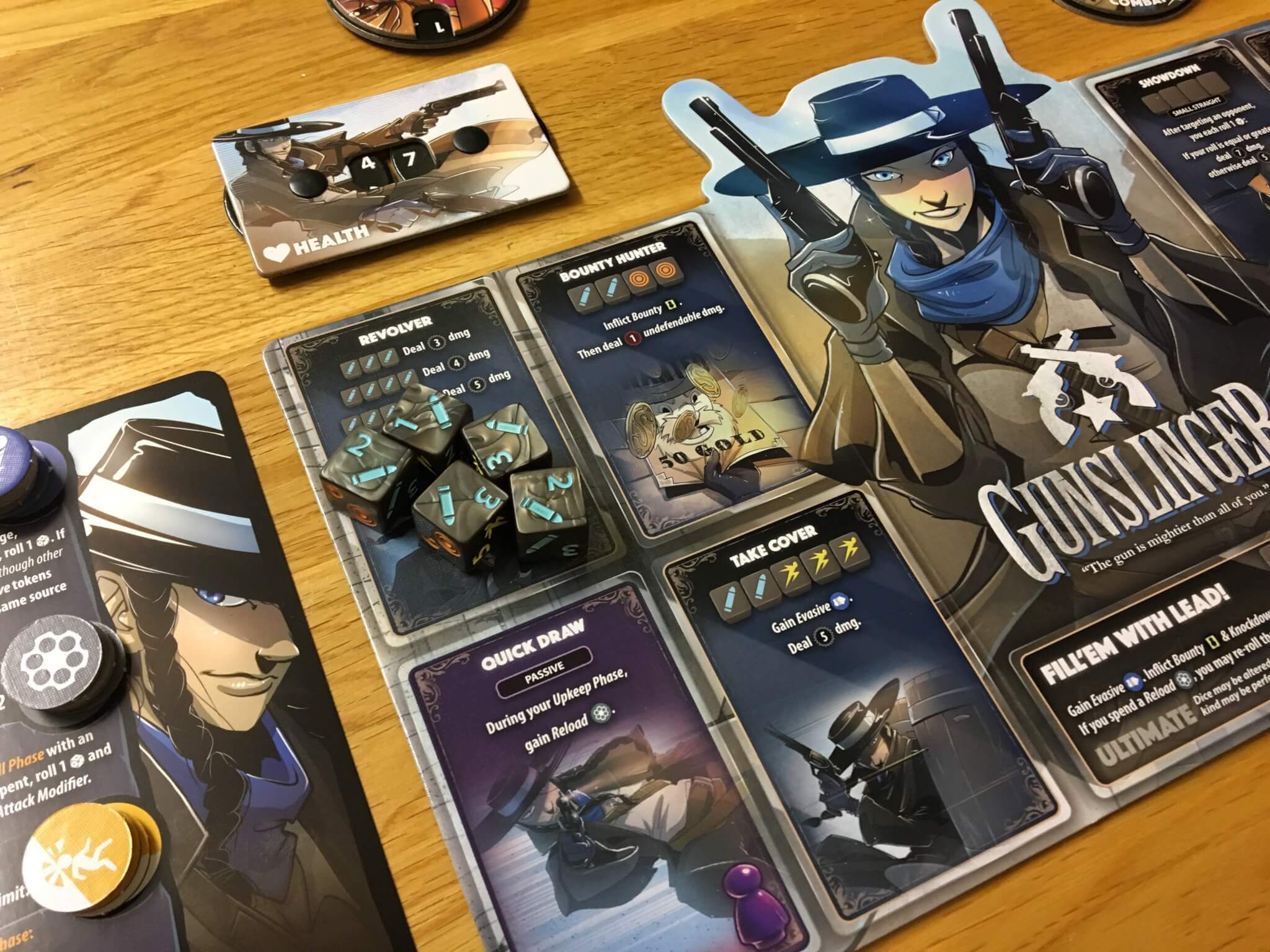
The use of combat points (which feels like a generic term used to cover “any form of income as appropriate to the character in question” to me) is a big addition to the standard loop of rolling dice, and it enables some very cool features. Aside from the character specific abilities I’ve just mentioned, the upgrades are a very simple, but fun and unusual way of changing the game so that it finishes in a timely manner and to ensure that it is ever changing.
As a basic example of the upgrade mechanism, basically every skill that a character has, including their basic attack, can be upgraded to a more powerful variant. This means that even if you do feel like hits deal little damage early in the game, your character will do more and more damage by rolling the same dice as the game goes on. This brings a sense of inevitability to proceedings where some dice rolling games can feel like both players are just chucking their dice over and over until one or the other rolls an elusive six.
On the subject of actually rolling the dice, when an attack roll phase happens in Dice Throne: Season Two, the attacking player has up to three rolls to achieve whatever set of dice results they want. Usually, a player will want to aim for the most powerful attack they can muster, potentially including their super move, or one of several special attacks. Sometimes you’ll focus on dealing a small amount of unblockable damage, whilst on other rolls you’ll just be happy to get four symbols that make any worthwhile attack happen.
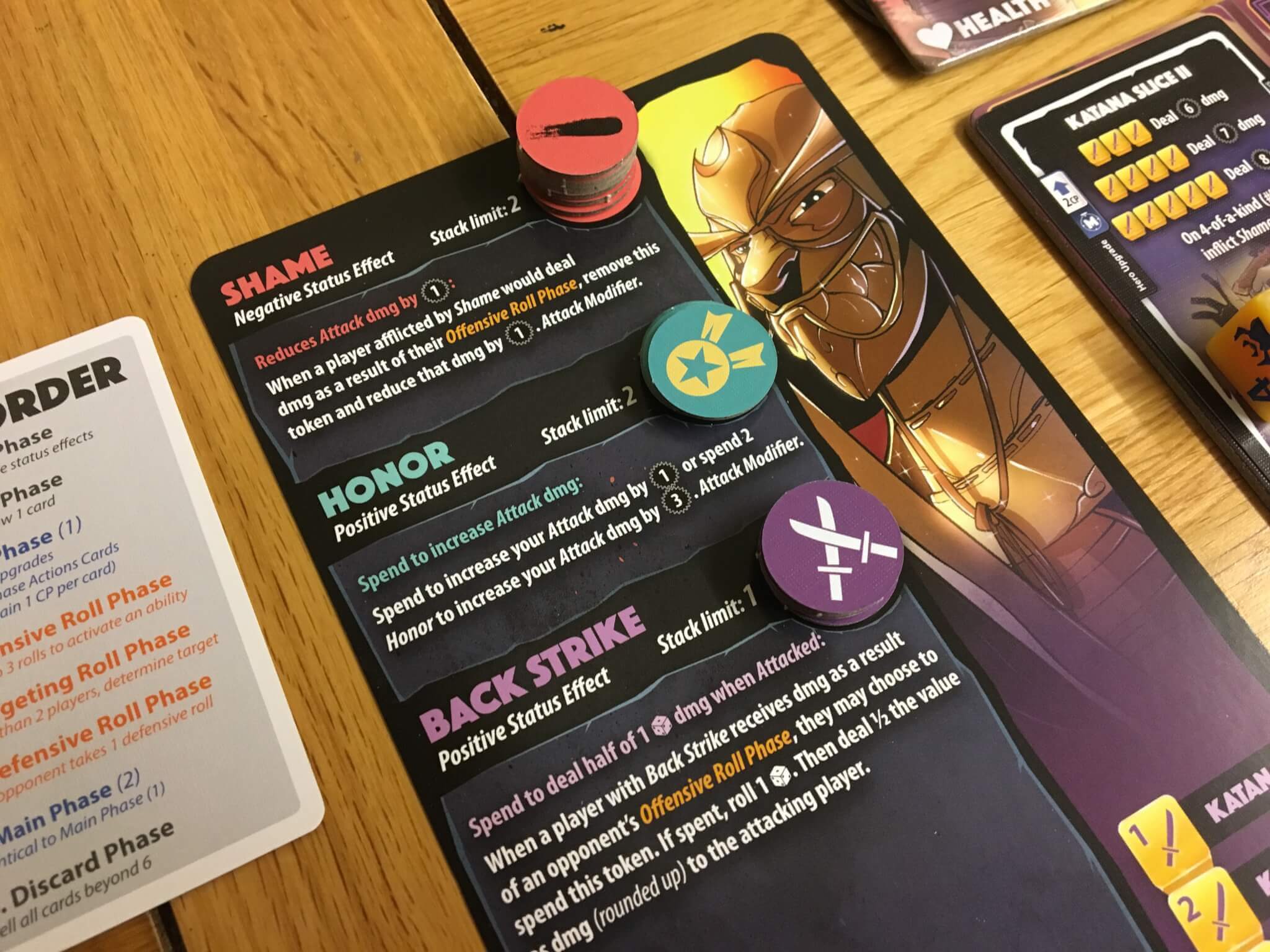
As I mentioned earlier, these rolls can often be modified by cards, or even by upgrades that you’ve already played, and as such there’s a fair bit of information to keep track of. Luckily, the player boards in Dice Throne: Season Two are exceptionally clear and upgrade cards can simply be placed to overlay the basic skill that they replace.
When an attack roll is locked in, the opposing player has the chance to perform a defence roll, which may allow them to reduce the damage taken to some extent. Each character has a different defence skill, but in general, the purpose of the defence roll (aside from reducing the damage directly) is to make the defending player feel involved and occasionally, to compensate them for taking a hit. In some cases, for example, a wounded player will gain a token or an effect when damaged.
Each game of Dice Throne: Season Two lasts only maybe fifteen or twenty minutes, with the players rolling dice, trading blows, upgrading their characters to become more powerful and attempting to setup a big strike that will take out their opponent. There’s an absolute ton of luck involved, but the introduction of the deck of cards means that the players do (or at least feel they do) have some control over proceedings.
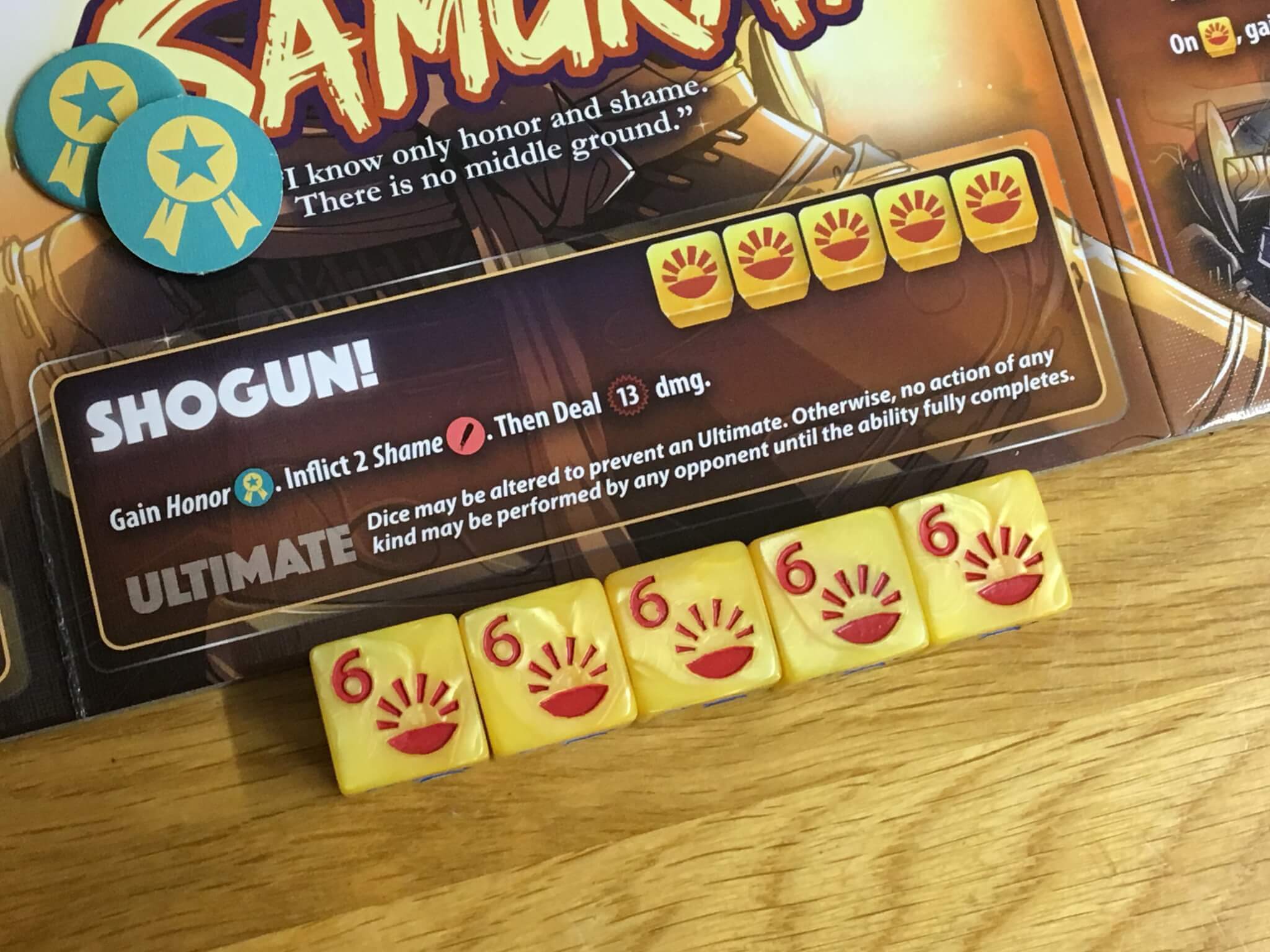
Personally, I’d love to have first hand experience of more characters from the Dice Throne: Season Two collection, but based on the gunslinger and samurai characters, I can say that Dice Throne: Season Two is a very enjoyable, very light and hugely accessible dice rolling game that largely escapes the problems of the genre. The reliance on luck is reduced a fair bit compared to similar games, but beyond that, it feels as though it is reduced to almost nothing when you actually play the game.
I would certainly recommend Dice Throne: Season Two to anyone looking for a light but innovative dice based game, or for someone who is looking to introduce board games into the life of a younger player – maybe aged around ten to twelve. I think the collectability of the series as well as the reasonable price point for each pairing makes Dice Throne: Season Two an attractive gift, and for those who find themselves hooked, Dice Throne Adventures may provide a deeper, longer term experience.
Dice Throne: Season Two: Gunslinger vs Samurai is available for purchase now, including on Amazon. You can also find out more about it at the website of the publisher, Roxley Games.

Comments are closed.